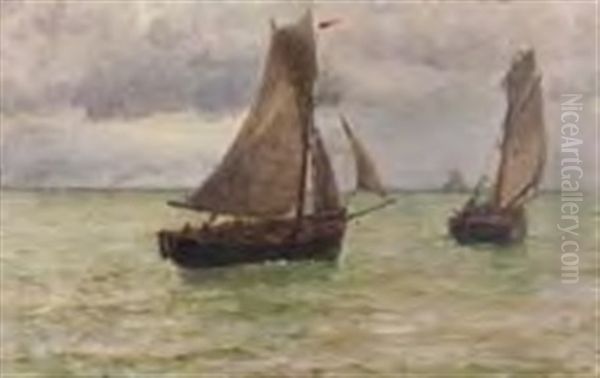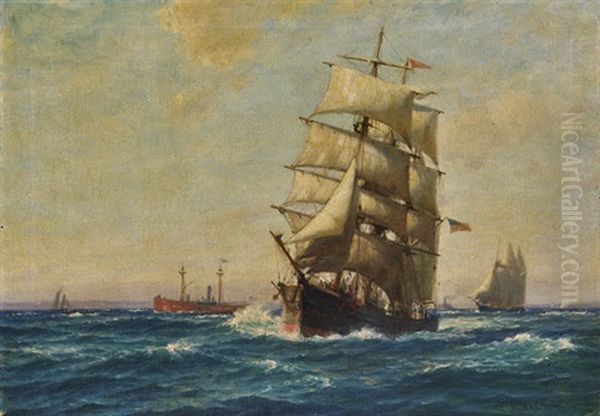William Edward Norton (1843-1916) stands as a significant figure in American art history, particularly renowned for his evocative and skillfully rendered marine paintings. Born in Boston, Massachusetts, the heart of a burgeoning maritime nation, Norton's life and art were inextricably linked to the sea. His canvases capture the power, atmosphere, and daily life associated with the oceans and the vessels that traversed them, earning him recognition both in the United States and Europe during his lifetime.
Early Life and Maritime Roots
Norton's affinity for the sea was cultivated from his earliest years. Born into a family with deep roots in the shipbuilding industry of Boston, the sights and sounds of maritime activity were part of his upbringing. This environment provided a rich tapestry of inspiration, immersing him in the world of ships, sailors, and the ever-changing moods of the ocean. His childhood was reportedly filled with sea adventures, experiences that would later infuse his artwork with authenticity and a palpable sense of place.
Further cementing his connection to the maritime world, Norton served in the Navy during his youth. This direct experience aboard ships, navigating waters and witnessing the routines and challenges of life at sea, offered invaluable firsthand knowledge. It provided him with an intimate understanding of ship construction, rigging, and the dynamic interplay between vessels and the elements – details that would later be rendered with convincing accuracy in his paintings.
Artistic Formation: America and Europe
Norton's formal artistic journey began not on the coast, but through structured education. He attended the Lowell Institute in Massachusetts, a center for public education and lectures. It was here, significantly, that he studied under the influential American landscape painter George Inness (1825-1894). Inness, known for his Tonalist landscapes imbued with a poetic and spiritual quality, likely imparted to Norton a sensitivity to atmosphere and the expressive potential of light and color, elements that would become hallmarks of Norton's own marine work. Some accounts also mention brief attendance at Harvard Medical School, suggesting a broad intellectual curiosity before fully committing to art.

Seeking to further hone his craft, Norton, like many ambitious American artists of his generation, traveled to Europe in the 1870s. Paris, the undisputed center of the Western art world, was a key destination. There, he sought instruction from established French artists. Notably, he studied under Antoine Vollon (1833-1900), a painter celebrated for his rich still lifes and landscapes, known for his vigorous brushwork and mastery of texture. Exposure to Vollon and the broader Parisian art scene, potentially including interactions with Realist painters like Gustave Courbet (1819-1877) or Barbizon School artists focused on naturalism, would have broadened Norton's technical skills and artistic perspective.
Following his studies in Paris, Norton established himself in London. This move proved pivotal, as he dedicated himself to becoming a preeminent marine painter. The bustling Thames River, with its constant traffic of commercial vessels, and the varied coastlines of England offered him abundant subject matter. He spent considerable time capturing the unique light and atmosphere of the British maritime environment, developing a distinct style characterized by its rich tonality and atmospheric depth.
Style and Thematic Focus
William Edward Norton's artistic output is overwhelmingly centered on marine subjects. His deep familiarity with ships, born from his upbringing and naval service, is evident in the confident and knowledgeable depiction of various types of vessels, from fishing boats and coastal schooners to larger merchant ships and whaling vessels. He possessed a keen eye for the architecture of ships and the complexities of their rigging against sky and sea.
Beyond mere representation, Norton excelled at capturing the feeling of the sea. His works are noted for their strong sense of atmosphere, whether depicting the calm of a harbor at dawn, the drama of a storm-tossed ship, or the hazy light of the London docks. He demonstrated a sophisticated understanding of light and shadow (chiaroscuro) and color harmony, using these elements to create mood and convey the time of day or weather conditions effectively. His brushwork could range from detailed rendering, particularly in the ships themselves, to broader, more suggestive strokes in the water and sky, contributing to the overall atmospheric effect.
While influenced by the poetic naturalism of his teacher George Inness, Norton's style also reflects European academic training and an awareness of Realism. He was less concerned with the Impressionistic dissolution of form seen in contemporaries like Claude Monet (1840-1926), though he shared an interest in capturing fleeting effects of light and atmosphere, particularly evident in his Thames scenes, which echo the earlier atmospheric explorations of J.M.W. Turner (1775-1851) or the coastal studies of Eugène Boudin (1824-1898).
Representative Works

Several key paintings exemplify Norton's skill and thematic interests. Onward is a compelling work noted for its masterful use of light and shadow. It captures the quiet anticipation of ships waiting to set sail, balancing areas of bright illumination with deep shadow, creating a harmonious composition that draws the viewer into the scene.
Norton also tackled the dramatic subject of whaling, drawing perhaps on historical accounts or tales heard during his maritime youth. Works like South Sea Whaling, Vae Victis — The Cachalot Cutting-In, and The Cachalot Trying-Out At Night depict the arduous and often dangerous process of the whale hunt and processing the catch. These paintings showcase his ability to handle complex, active scenes, often under dramatic lighting conditions, such as the nocturnal rendering of the 'trying-out' process (boiling down blubber), illuminated by the fire's glow against the dark sea and night sky. An oil sketch for South Sea Whaling further reveals his working process, capturing the energy and detail he aimed for in the final piece.
His London period yielded numerous depictions of the Thames River, capturing its industrial energy and unique atmospheric conditions. These works often feature tugboats, barges, and the general maritime commerce of the era, rendered with his characteristic attention to detail and mood.
Recognition and Exhibitions
Norton achieved considerable recognition during his career. His skills were acknowledged through acceptances and accolades at prestigious international venues. He exhibited regularly at the Royal Academy of Arts in London, a major achievement for an American artist working abroad. His work was also accepted into the highly competitive Paris Salon, where he received an honorable mention in 1895, a significant mark of distinction from the French art establishment.
His participation was not limited to Europe. Norton's paintings were featured in major American exhibitions, including the World's Columbian Exposition held in Chicago in 1893. This international fair was a crucial platform for American artists to showcase their work to a global audience. The inclusion of his paintings underscored his standing within the American art scene. His works eventually found their way into various collections, including galleries in Paris and London, as well as American museums, ensuring their visibility for future generations.
Contemporaries and Artistic Context
Norton worked during a dynamic period in American and European art. In America, the Hudson River School's grand landscape tradition, exemplified by artists like Albert Bierstadt (1830-1902) and Frederic Edwin Church (1826-1900), was still influential, though newer styles were emerging. Norton's focus on marine subjects placed him alongside other notable American marine painters. Winslow Homer (1836-1910), arguably the most famous American marine artist of the era, depicted the sea with a powerful, often stark realism, focusing on the relationship between humanity and the elemental forces of nature.
Other American contemporaries specializing in marine art included Fitz Henry Lane (1804-1865), whose earlier Luminist style emphasized calm light and meticulous detail, and James E. Buttersworth (1817-1894), known for his dramatic and precise ship portraits, particularly of racing yachts. Edward Moran (1829-1901), part of the talented Moran family of artists, also gained fame for his marine views, often depicting historical naval events or coastal scenes with a romantic flair. While Norton shared their subject matter, his style, influenced by Inness and his European training, offered a distinct blend of atmospheric sensitivity and detailed realism.
In Europe, Norton's time coincided with the rise of Impressionism and Post-Impressionism. While not an Impressionist himself, his attention to light and atmosphere connects him to the broader artistic currents of the time, seen in the work of Monet and Boudin. His realistic depiction of maritime labor also finds echoes in the Realist movement championed by Courbet or the depictions of rural labor by Jean-François Millet (1814-1875) of the Barbizon School. Some of his moodier, more atmospheric pieces might even evoke a comparison, though perhaps distant, to the subjective and enigmatic seascapes of the American visionary Albert Pinkham Ryder (1847-1917).
Later Life and Legacy
After spending a significant portion of his career in Europe, particularly London, William Edward Norton eventually returned to the United States. He settled in New York City, which by the late 19th and early 20th centuries had become the primary center for art in America. He continued to paint and maintain his studio there until his death in 1916. His return allowed him to reconnect with the American art scene, though his reputation was already established through his international successes.
Norton's legacy rests on his dedication to marine painting and his ability to convey the multifaceted character of the sea and maritime life. He successfully bridged American artistic sensibilities with European training, creating a body of work respected for its technical skill, atmospheric depth, and authentic portrayal of its subject matter. His paintings serve as valuable visual documents of a specific era of maritime activity, particularly the age of sail and early steam, capturing the vessels and waterfronts of Boston, London, and the open ocean.
He is remembered as a talented and serious artist who pursued his chosen specialty with passion and expertise. His works continue to be appreciated by collectors and museum-goers for their evocative beauty and historical interest, securing his place among the notable American painters of the late 19th and early 20th centuries. His life story, from a shipbuilding family in Boston to the art studios of Paris and London and back to New York, reflects the journey of an artist deeply connected to the maritime world he so skillfully depicted.
Conclusion
William Edward Norton carved a distinct niche for himself within the realm of American art. As a dedicated marine painter, he brought a wealth of personal experience and rigorous artistic training to his canvases. His ability to capture not just the appearance but the essence of the sea – its light, atmosphere, and the vessels that navigated it – distinguishes his work. From the bustling docks of the Thames to the dramatic encounters of whaling ships in distant oceans, Norton's paintings offer a compelling vision of the maritime world. Recognized in the major art centers of his day, his legacy endures through works that continue to resonate with viewers, celebrating the enduring allure and power of the sea.